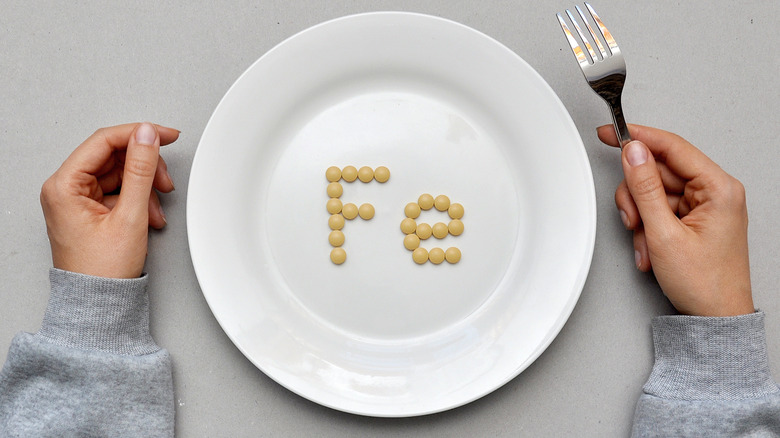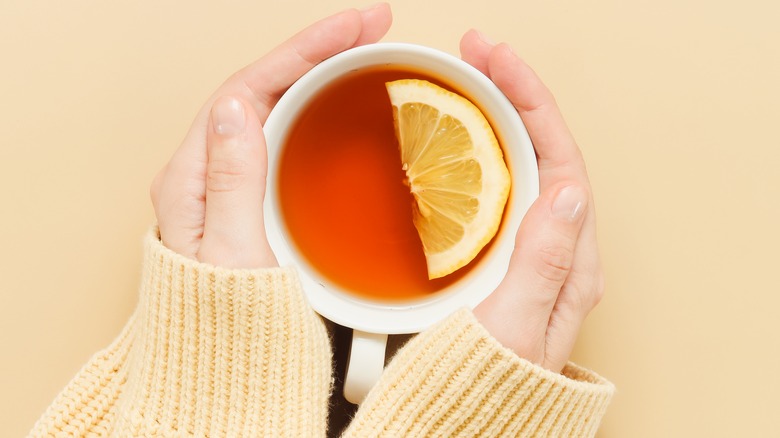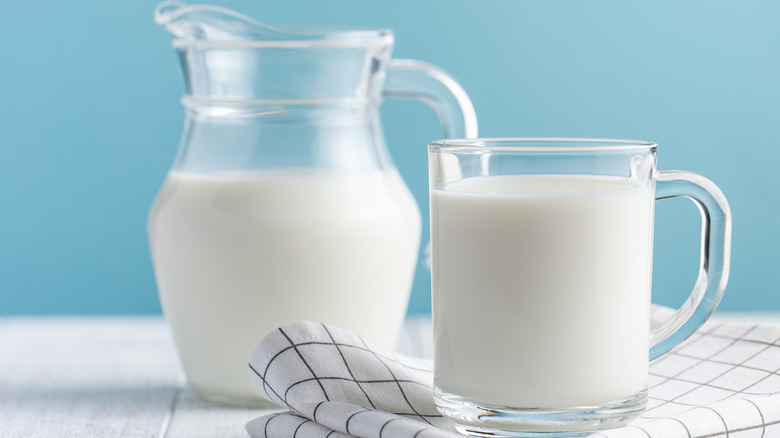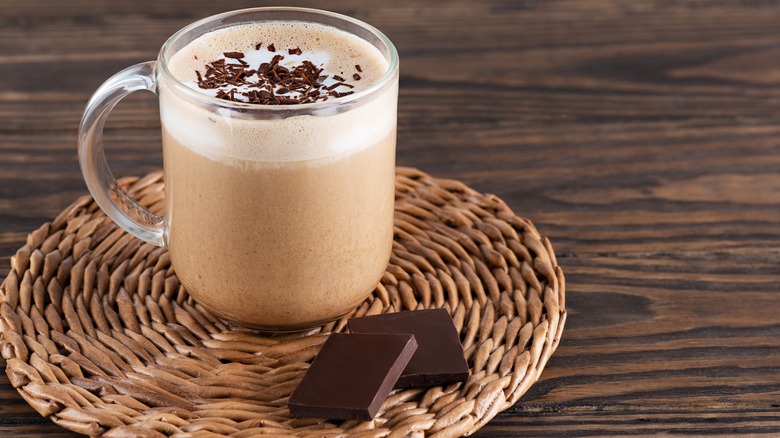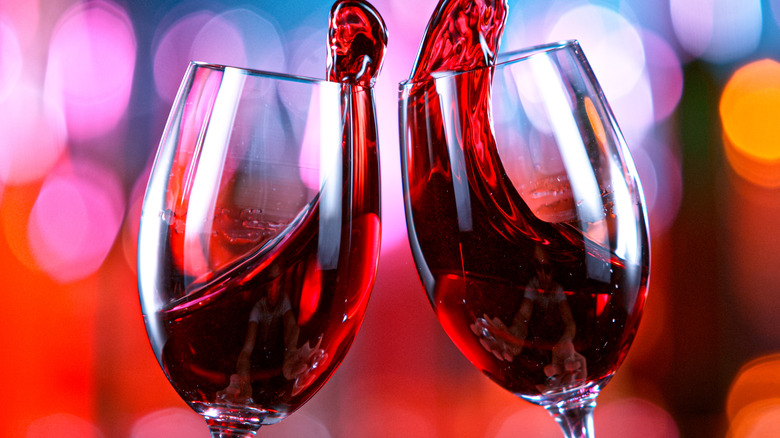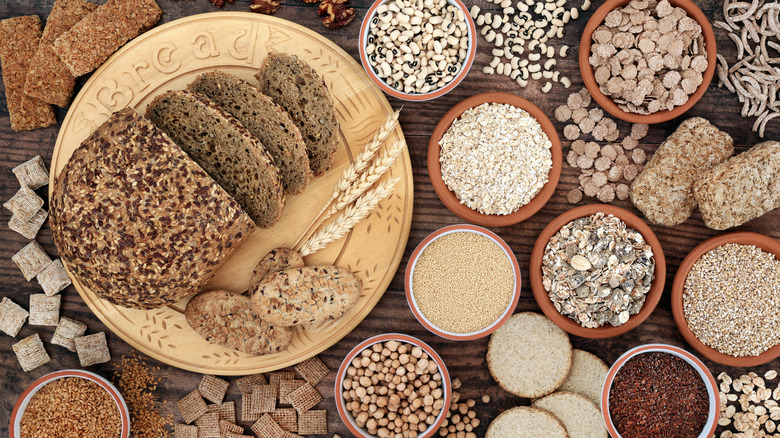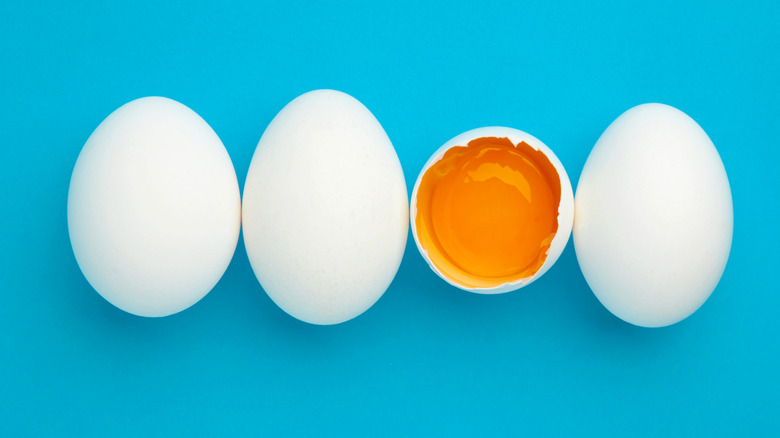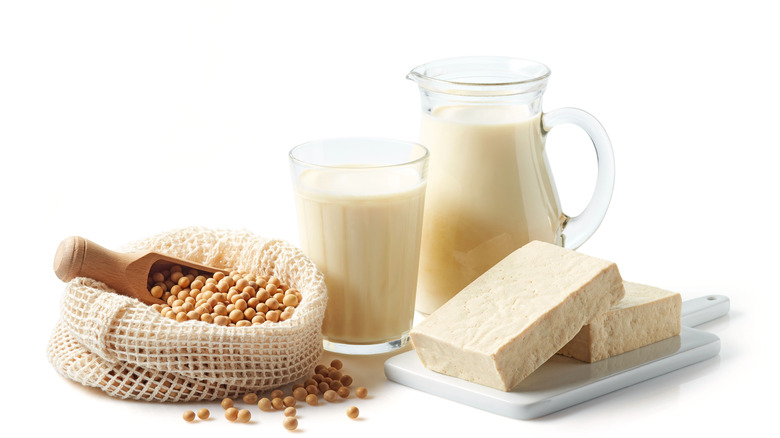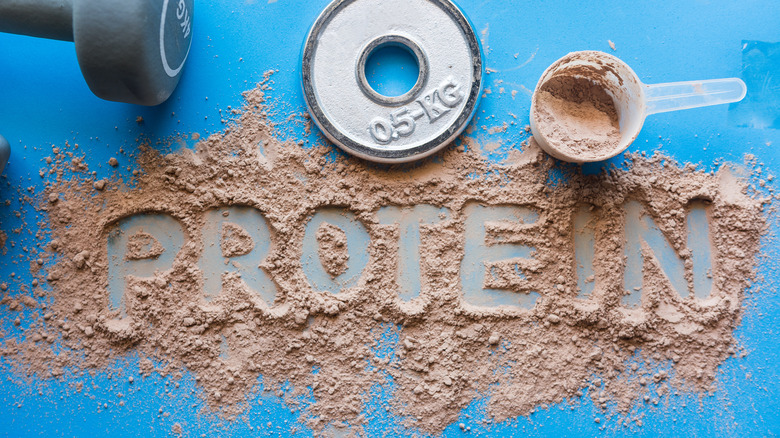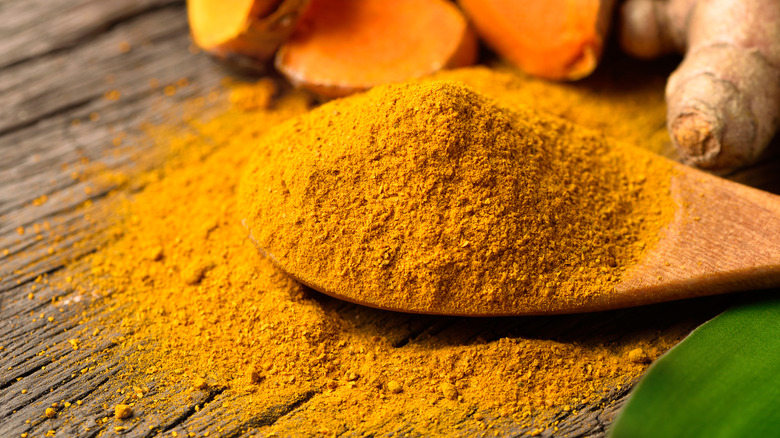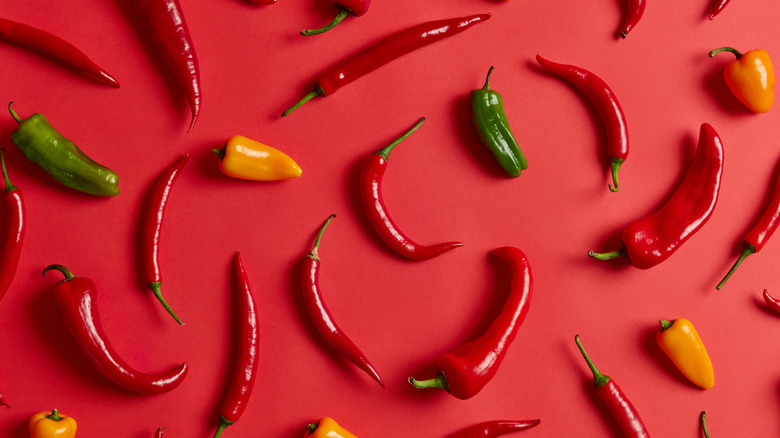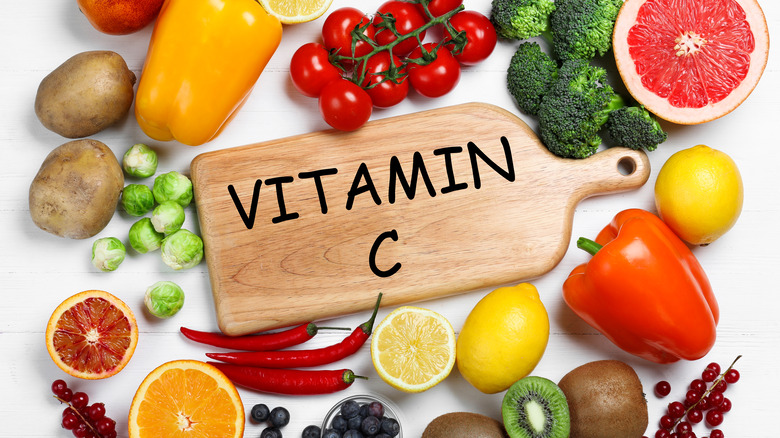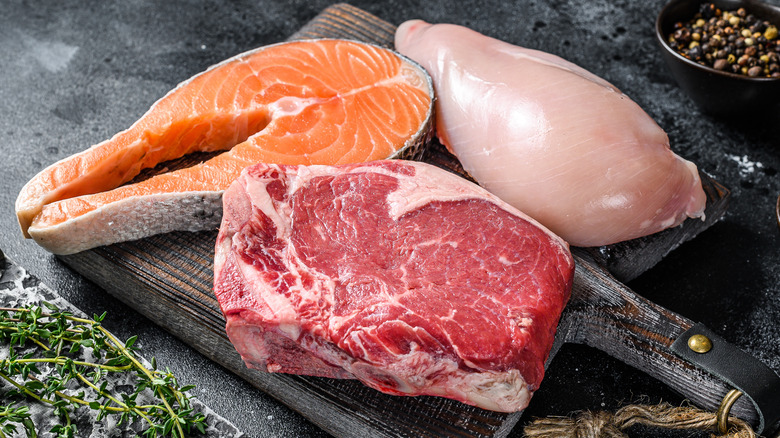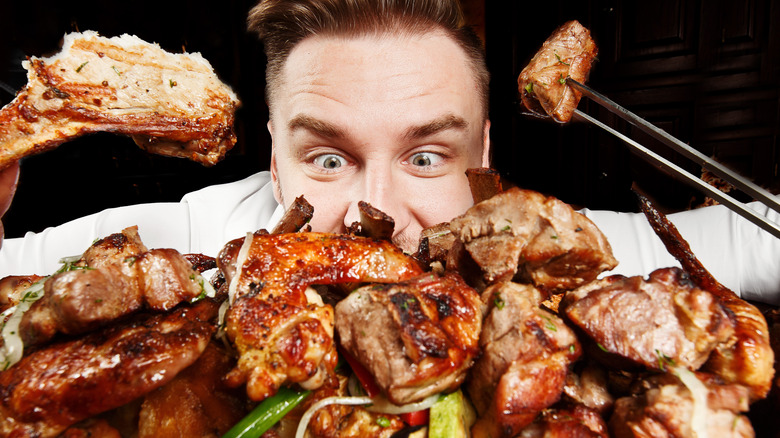Foods To Avoid If You Have An Iron Deficiency
Have you ever felt that no matter how many hours of sleep you get at night or how many naps you take during the day, the tiredness or exhaustion just won't go away? While there are countless reasons why you may feel extreme fatigue, one simple explanation could be that you have an iron deficiency.
Iron is a mineral that can be naturally found in multiple foods. In your body, iron is bound to hemoglobin, a red blood cell that's in charge of carrying oxygen from your lungs to your tissues (via the National Institutes of Health). When you have an iron deficiency, hemoglobin can't transport oxygen to your cells. And since we all need oxygen to live, without it, your body simply can't function properly, making you feel easily tired or like you just ran a marathon when you've only walked to the bathroom. This is a condition known as iron deficiency anemia (per the Mayo Clinic).
Aside from the fatigue and shortness of breath, iron deficiency anemia is also characterized by symptoms like pale skin, irregular heartbeat, chest pain, dizziness or lightheadedness, sore tongue, brittle nails, poor appetite, cold hands and feet, and cravings for substances such as dirt or ice. Luckily, you can easily treat this condition with iron supplementation. However, you might also want to be mindful of what you eat and when you eat it. While certain foods may boost iron absorption, others actually hinder it.
Tea
For some people, tea is the ultimate home remedy to cure all ailments, and while sipping a cuppa offers multiple health benefits more often than not, you may want to rethink your choice of tea if you want to improve iron absorption. Green, black, and oolong teas are made from the dried leaves of Camellia sinensis, also known as the tea plant. The plant has been cultivated for hundreds of years, and its teas have been consumed for just as long for medicinal purposes due to their high content of polyphenolic compounds, according to a review published in Current Pharmaceutical Design.
However, per a 2020 review published in the Journal of Nutrition and Metabolism, polyphenols can inhibit iron absorption in the intestines. The inhibitory effect is dose-dependent, which means that the higher your polyphenol intake, the more it will block iron uptake. Unfortunately, tea already has quite a potent inhibitory effect, according to an older study published in the American Journal of Clinical Nutrition: a single cup of tea can reduce iron absorption by 64%.
Nevertheless, not all is lost when it comes to enjoying a hot drink during those cold winter months. While herbal infusions and teas are two terms often used interchangeably, they're not the same thing. Herbal infusions are made by steeping the dried leaves, fruits, or flowers of plants other than Camelia sinensis. Therefore, they can be a great alternative to black, green, and oolong teas because they contain little to no polyphenols (via LiveStrong).
Dairy
According to the National Institutes of Health (NIH), about 72% of calcium intake in the United States comes from dairy products. While calcium is essential for bone health, it's actually unfavorable when it comes to iron absorption.
According to an article published in The American Journal of Clinical Nutrition, calcium inhibits the absorption of iron from both animal and plant sources. Calcium from dairy products had an inhibitory effect at doses as small as 165 milligrams per serving. (For reference, a standard 240-milliliter cup of milk provides 300 milligrams of calcium, per the USDA Food Data Central. Nevertheless, despite the negative effects of calcium on iron absorption, consuming both minerals together with a variety of foods and other absorption-enhancing substances may actually reduce calcium's inhibitory properties. Similarly, another review (via the International Journal for Vitamin and Nutrition Research) determined that calcium's effect on iron uptake has a short duration, and that the body may adapt to prevent iron deficiencies in people who take calcium supplements.
Still, although plant-based products are the most common replacements for dairy products, a review published in Nutrients states that plant-based milks like almond, rice, soy, or oat milk contain high phytate levels, another potent iron inhibitor. Therefore, it would be best to avoid consuming dairy products at the same time as iron-rich foods or supplements. Also, keep in mind that dairy is not the only source of calcium in the diet. Other important natural sources include sardines, salmon, tofu, soybeans, spinach, turnips, kale, chia seeds, and bok choi (via NIH).
Coffee and cocoa
If the never-ending tiredness that comes with an iron deficiency has you thinking about chugging one cup of coffee after another, you might want to think again. Compounds in coffee and cocoa may actually worsen your symptoms by impairing iron absorption. An older study published in the British Journal of Nutrition found that compounds in cocoa inhibited iron absorption by 71%. Similarly, according to older research published in the American Journal of Clinical Nutrition, a cup of instant coffee reduced iron absorption from 5.88% to 0.97%, and even lowered it to 0.53% when the strength of the coffee was doubled.
Per a 2022 study published in ACS Omega, polyphenols found in coffee and cocoa are one of the major iron absorption inhibitors. According to the study, polyphenols bind to iron in the gastrointestinal tract, making it less available for absorption. In addition, they have been linked to impaired absorption of both heme and non-heme iron, the type of iron that comes from animal and plant sources, respectively.
On the other hand, caffeine from both drinks also acts as an iron inhibitor by binding to it during digestion. However, per a 2004 study published in Food Chemistry, caffeine's effect on the mineral's absorption is much less potent than polyphenols' effect, seeing that it only binds to 6% of the available iron. Still, this doesn't mean you have to give up coffee altogether; just make sure to consume it at least one hour before or after a meal (via Healthline).
Red wine
You might want to skip red wine (or choose a different type) while treating an iron deficiency. According to a 2020 review published in the Journal of Nutrition and Metabolism, while alcohol itself acts as a promoter of iron absorption, this effect does not apply to red wine due to its high polyphenol content — meaning that the same compounds that give it its multiple known health benefits are the ones that keep the mineral from entering your system.
Per the review, the main types of red wine polyphenols responsible for blocking iron absorption are tannins. Their inhibitory effect depends on the dose: For example, adding 5 milligrams of tannic acids to an iron-containing meal inhibited its absorption by 20%. In contrast, adding 100 milligrams reduced it by 88%. Tannins are especially present in red wines aged in oak barrels. However, other dietary sources to look out for include dark chocolate, pomegranate juice, grapes, coffee, and tea.
Nevertheless, you can still enjoy the occasional glass of white wine. According to an older study published in the Scandinavian Journal of Hematology, white wine has a much lower polyphenol content than red wine, so it doesn't seem to interfere with iron absorption. In fact, the study determined that when 3 milligrams of iron were added to both wines, red wine only allowed for 20% of it to be absorbed, while over 4 times as much iron was absorbed from white wine. Even so, remember to always drink in moderation.
Whole grains and legumes
You've probably heard over a million times how a diet low in processed foods and added sugars but rich in whole grains and legumes is one way to go if you want to lead a healthier lifestyle. Yet, you most likely don't know that whole grains and legumes can cause more harm than good when it comes to iron deficiency.
But how is it that iron-rich foods such as legumes won't do much for you if you have an iron deficiency? Well, both whole grains and legumes are good sources of insoluble fiber — the type of fiber that doesn't dissolve in water, but helps with the passage of food through the intestines, preventing constipation (via the Harvard T.H. Chan School of Public Health). However, regardless of how beneficial insoluble fiber is for your overall health, it is known to inhibit mineral absorption, including iron, according to a 2022 study published in ACS Omega.
Additionally, whole grains and legumes both contain an anti-nutrient called phytate, one of the most significant iron-absorption inhibitors from plant-based foods. In fact, a 2017 review published in Molecules determined that phytate compromises the mineral balance of people following dietary patterns with high intakes of grains and legumes and low intakes of animal proteins, especially in vulnerable populations such as children or people with mineral deficiencies. Nevertheless, experts advise not to eliminate these foods altogether, seeing that cooking helps reduce their phytate content, along with other preparation methods such as soaking, sprouting, and fermenting (via Healthline).
Egg yolk
Eggs are a highly nutritious and versatile food found in kitchens all over the world. Nutritionally speaking, the yolk is rich in healthy fats, fat-soluble vitamins, minerals, and even some proteins — although egg whites tend to provide a slightly higher amount of this nutrient (per Medical News Today). Still, regardless of how nutritious they are, according to a 2007 study published in the Journal of Food and Science, egg yolks reduce iron absorption.
Among the proteins found in egg yolks, one in particular, called phosvitin, stands out when it comes to iron uptake. According to a 2015 study published in Nutrients, while egg yolks are a source of iron, most of it is combined with phosvitin, which has a strong binding capacity to certain minerals, especially iron, therefore impairing its absorption. In the study, researchers evaluated the effect of feeding an egg yolk- versus an egg white-supplemented diet to rats with iron deficiency anemia (IDA). They determined that egg yolk delayed the recovery of blood markers associated with the disease due to its phosvitin content, resulting in no recovery from IDA during the experiment. In contrast, an egg white protein called ovalbumin was found helpful for IDA recovery. Therefore, while eating whole eggs has numerous health benefits, you might want to stick to egg whites if you have an iron deficiency.
Soy products
According to the USDA Food Data Central, a 1-cup (185 grams) serving of soybeans provides almost 50% of your daily iron needs. Still, despite being such a rich plant-based source of iron, soybeans also contain high amounts of multiple iron-absorption inhibiting compounds.
For starters, soybeans are quite a rich source of calcium. In fact, they provide over twice as much calcium per serving than skimmed milk, and according to a 2020 study published in the Journal of Nutrition and Metabolism, calcium is a contributing factor to soy's low iron availability. Furthermore, the study explains that non-GMO soybeans are a good source of phytates, a well-known potent inhibitor of iron absorption. Yet, according to a 2013 review published in Nutrients, there's still some interference with iron absorption once phytates are removed, which implies that other compounds must be involved. In this case, researchers believe soy protein is the culprit.
From soy milk to tofu, tempeh, miso, edamame, soy sauce, soy flour, soy nuts, and meat alternatives, soy protein is increasingly available in numerous foods (via UCSF Health). Therefore, keep an eye out for sneaky ways it might sabotage your iron deficiency recovery.
Milk proteins
Milk is a nutrient-dense food loaded with high-quality protein. It is made from casein and whey, which make up 80% and 20% of cow's milk total protein content, respectively, according to Mark Pikosky, Ph.D., RD, FACN (via Undeniably Dairy). While you might be familiar with casein and whey proteins from their renowned use in the fitness industry and their many benefits for athletic performance, they might not be the best allies when trying to replenish your iron reserves.
According to an article published in The American Journal of Clinical Nutrition, both casein and whey from cow's milk have been shown to block iron absorption in humans. One potential explanation, per a 2005 study published in Pediatric Research, is that milk proteins have such a strong affinity for iron that once they bind to it, it cannot be released, making it unavailable for absorption. However, the study also states that breaking down cow's milk proteins — a process known as hydrolysis — may actually enhance the mineral's absorption. Therefore, if you're planning on consuming casein or whey protein supplements, aim for those that come in a hydrolyzed form and avoid drinking cow milk, which, aside from containing both proteins in their complete form, is also a good source of calcium, another iron inhibitor.
Turmeric
Have you ever wondered what gives curry and golden milk their vibrant yellow color? The answer is turmeric, a spice that has been long used in China and India for both culinary and medicinal purposes thanks to its curcumin content, its main active ingredient (via Healthline). However, as beneficial as turmeric might be for preventing numerous diseases, it might actually have a detrimental effect on your body's iron stores.
According to an animal study in the journal Blood, adding turmeric to the diet of mice resulted in iron deficiency anemia (IDA), and even led to reduced iron levels in the animal's bone marrow. The bone marrow relies on its iron stores to produce red blood cells. If the bone marrow is running low on iron, the production of red blood cells becomes impaired, leading to IDA (per Live Healthy).
Furthermore, according to a 2019 article in Cureus, turmeric is known to inhibit iron absorption in humans. In fact, it is believed to block its uptake by up to 90%. There are two potential mechanisms for this effect. First, curcumin in turmeric strongly binds to iron, reducing its availability. Additionally, curcumin blocks the production of hepcidin, a protein that regulates the entry of iron into the bloodstream. In any case, turmeric intake was directly associated with iron deficiency. In fact, turmeric's effect is so strong that it is even recommended to reduce iron buildup in people with hematomachrosis, a condition that leads to excess iron in the body, per Dr. Eric Lewis, ND (via Hematomachrosis Help).
Chilies
From habaneros to jalapeños or chipotle peppers, chili peppers are considered a healthy spice due to their rich nutritional profile and potential health benefits (via Healthline). Yet, research seems to be a bit divided when it comes to chilies and iron.
On the one hand, they're a rich source of iron and vitamin C, a potent iron-absorption enhancer. But on the other hand, like many other fruits and vegetables, chilies are high in polyphenols and phytate, the main inhibitors of iron absorption, per a 2014 study published in the Journal of Medicinal Food.
A 2009 study published in the International Journal of Food Sciences and Nutrition supports the second notion by concluding that polyphenols in chilies have the potential to reduce the availability of iron in foods. In the study, researchers tested the effect of six different spices on iron absorption, including chilies, and determined that they all had a polyphenol content ranging from 0.5 to 33 milligrams, which reduced iron availability by up to 90%. Thus, just to be sure, steer clear of spicy foods when treating an iron deficiency.
Vitamin C boosts iron absorption
While some foods are known to inhibit iron absorption, others can offer the opposite effect and actually enhance iron's availability so that your body can make the most out of the mineral — and such is the case for vitamin C. According to a report published in the International Journal for Vitamin and Nutrition Research, ascorbic acid, commonly known as vitamin C, is the most efficient enhancer of iron from plant sources.
A 2020 study published in the Journal of Nutrition and Metabolism explains that while some foods bind to iron and form an insoluble and unabsorbable compound, vitamin C binds to it to create a soluble compound that facilitates its absorption. In addition, vitamin C also seems to convert iron from ferric to ferrous form, which further promotes its absorption. Therefore, be sure to consume iron-rich plant foods or supplements with vitamin C-rich foods, such as citric fruits, broccoli, tomatoes, or bell peppers (via the National Institutes of Health).
Animal meats promote iron uptake
If you're a meat lover, we've got good news for you: animal meats are a great way of fighting iron deficiency. A 2010 study published in The American Journal of Clinical Nutrition explains that different types of meats may enhance iron absorption even in the presence of potent iron inhibitors such as phytate. Furthermore, they may boost iron uptake just like vitamin C, another known iron enhancer. And the best part? Pescatarians can also enjoy this benefit, seeing that the effect has been confirmed not only for pork, beef, and poultry, but also for fish. For example, according to the study, adding chicken, beef, or fish to a corn-based meal leads to a two- to three-fold increase in iron absorption.
While the enhancing effect of animal meats on iron absorption is known as the "meat factor," the exact mechanism hasn't been identified yet. Despite knowing that it is directly associated with animal muscle tissue, researchers seem to believe that there's more than a single element at play, according to a 2022 study published in ACS Omega.
Choose heme iron over non-heme iron sources
According to the National Institutes of Health (NIH), there are two types of dietary iron: heme and non-heme iron. Depending on your choice of foods, you might be consuming more of one over the other. The NIH explains that animal-based proteins such as poultry, meat, seafood, pork, and organ meats like liver contain both types of iron. In contrast, plant-based foods (such as legumes, nuts, and leafy greens), as well as iron-fortified foods, contain non-heme iron only.
While both types of iron can help you reach your daily iron goals, consuming heme iron from meats is a more efficient way of increasing your iron stores to fight a deficiency, because it is more bioavailable than non-heme iron. This means that a higher proportion of it will be able to enter your bloodstream and have an active beneficial effect on your health — or in other words, it is easier for your body to absorb and utilize it. In fact, heme iron has a bioavailability of up to 18%, compared to the 12% maximum bioavailability of non-heme iron from vegetarian diets (per Healthline).

